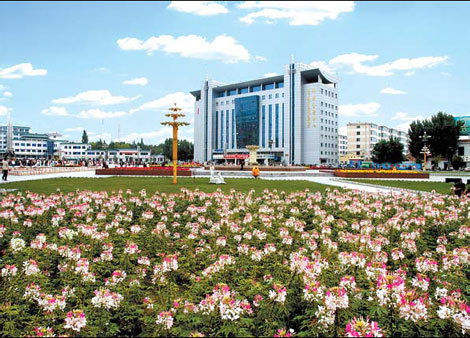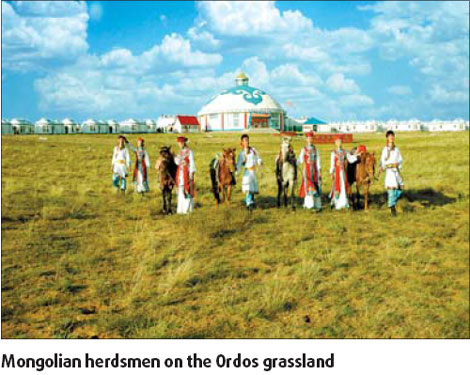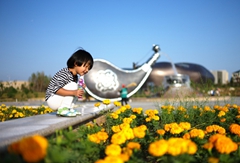More than grasslands growing in Ordos
Updated: 2017-03-18 (China Daily)  Print
Print 




The Ordos Square is the landmark of the city.
Rich in natural resources, with a long history, colorful culture, well-developed industries and a good environment, the city of Ordos has many attributes that beckon the ambitious to start a business, others to tour the countryside and for many to simply make a living.
In the south Inner Mongolia autonomous region surrounded by the Yellow River, the city limits of Ordos encompass 87,000 sq km and a population of 1.51 million, 170,000 of whom are ethnic Mongols.
In the Mongolian language Ordos means "many palaces", a name resonant of its brilliant and ancient civilization. Unearthed relics of human inhabitation in the region date back 35,000 years. In the 13th century Genghis Khan, impressed with the beautiful landscape, decided to build his mausoleum in Ordos.
Land around the city has more than 50 kinds of minerals including proven coal reserves of 167.6 billion tons, one-sixth of the nation's total. Its discovered natural gas reserves total 800 billion cu m, one-third of all in China.
The city is also the most important center for cashmere production in the country.
Ordos was long famous for its fertile grasslands, but its ecology deteriorated in the past century due to over-farming and excessive animal husbandry. Local government efforts in recent years have now helped improve the environment, with 75 percent of the city's land again covered by grass and trees.
Ordos has been a popular tourist destination for its unique landscape and colorful ethnic cultures. Traditional wedding ceremonies of the region and the sacrifice rite to Genghis Khan are listed among the country's intangible cultural heritages.
The region has convenient transportation and well-developed urban facilities, including a comprehensive transportation system of highways, railways and an airport.
With its rich resources, Ordos has made considerable progress in economic development, especially in its mainstay industries of coal mining, wool, cashmere, energy and chemicals.
Coal output in the city reached 200 million tons in 2007, compared with 26.79 million tons in 2000. It is the first modern coal mining center in China with an annual output surpassing 100 million tons.
The gross domestic product (GDP) of the city was 115.09 billion yuan in 2007, an average annual growth of 38.3 percent from 17.18 billion yuan in 2001. Per capita GDP reached $10,000 last year, compared with $1,572 in 2001. The city ranks the 28th among the top-100 Chinese cities in comprehensive economic strength.
Building on the achievements made in recent decades, city authorities have mapped out an ambitious blueprint for its future development.
According to the development plan proposed by the Ordos city government, the city is expected to realize its goal of building a "well-off society" in 2012, with its comprehensive economic strength joining the top 20 of all Chinese cities.
Its GDP and per capita GDP are projected to reach 300 billion yuan and $25,000 respectively in 2012, according to the development plan.
In addition, a comprehensive social security system covering education, pensions and medical services will be established in all its urban and rural areas.






 Ordos Impression
Ordos Impression Ordos WeChat
Ordos WeChat Ordos Reported
Ordos Reported


